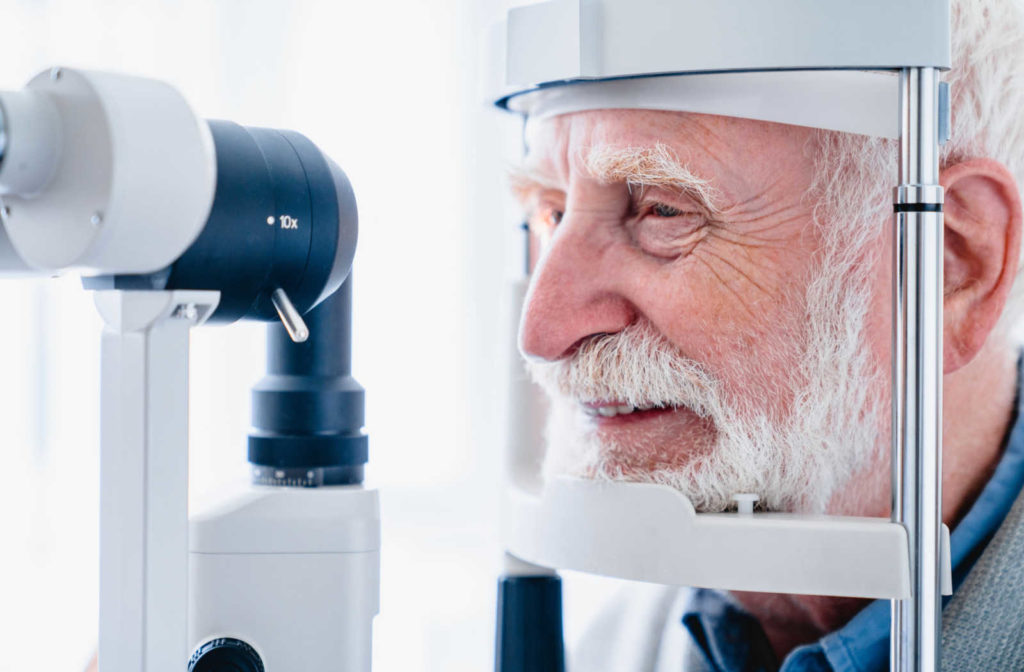It’s common for people to report seeing halos around lighting, especially at night. Sometimes, this isn’t a cause for any concern as it’s the eye’s response to bright lights, or even the result of wearing contacts or glasses.
It’s caused by diffraction, a phenomenon that occurs when a light beam passes through a narrow aperture (a hole that allows light in). The pupil is the aperture in the eye, when exposed to bright light, the pupil contracts, resulting in the appearance of a ring or halo around the light.
However, sometimes halos can be a signal for other health conditions that require a closer look. Especially when accompanied by symptoms like:
- Pain
- Blurred vision
- Blind spots
- Dry, red, or itchy eyes
If you’re seeing halos around lights, make an appointment with your trusted optometrist so they can examine your eyes properly and determine if there’s an underlying cause.
Potential Causes of Seeing Halos
Dry Eye Disease
Dry eye disease occurs when your tears are unable to lubricate your eyes adequately. For a variety of reasons, tear production is insufficient and unstable.
Tear instability causes inflammation and damage to the eye’s surface. Your eyes may sting, burn, or itch. In addition to seeing halos around lighting, other symptoms of dry eye disease include:
- Stringy mucus in or around your eyes
- Light sensitivity
- Eye Redness
- A feeling that something is in your eyes
- Wearing contact lenses may be difficult
- Eye strain or blurred vision
Dry eyes can be caused by several factors that disrupt the healthy tear film. Three layers make up the tear film: fatty oils, aqueous fluid, and mucus.
This combination normally keeps the surface of your eyes lubricated, smooth, and clear. Any of these layers can be the source of dry eyes.
Cataracts
A cataract is a cloudy area that develops in the eye’s lens. Cataracts form slowly and are common in the elderly. Clouding of the lens can result in the diffraction of light entering the eye, resulting in halos around light sources. You may also experience:
- Blurred vision
- Difficulty seeing in low light
- Sensitivity to glare
- Double Vision
Glaucoma
Glaucoma is an eye disease that can damage the optic nerve. The optic nerve is responsible for transmitting visual information from your eyes to your brain.
Glaucoma can be caused by abnormally high pressure inside your eye, though this is not always the case. As a result of the increasing pressure, your optic nerve tissue degrades over time, resulting in vision loss, halos around lights, or even blindness. Early detection allows you to prevent or slow further vision loss.

LASIK
Because of its effectiveness and quick healing time, laser-assisted in-situ keratomileusis, or LASIK, is one of the most commonly performed laser procedures. The procedure entails creating a small flap in the corneal tissue’s outer layer, known as the epithelium.
The flap is pushed back, exposing the corneal tissue beneath, which is reshaped with an excimer laser. The flap is then replaced to act as a natural bandage during the healing process, which usually takes about a week.
As a side effect, halos may appear. The halos typically last only a few weeks after surgery. Modern LASIK procedures are less likely to cause this side effect.
Migraines
The ocular migraine is a fairly rare type of migraine that causes visual disturbances. People with ocular migraines may see flashing or shimmering lights, zigzagging lines, and halos around lights in addition to a severe headache.
Photokeratitis
Photokeratitis is a painful, temporary eye condition caused by ultraviolet ray exposure. It’s sometimes compared to a sunburn, except it affects your eyes’ corneas.
UV rays are reflected off snow and ice, causing snow blindness. Typically, your symptoms will last only a few hours to a few days. Sunglasses can help prevent photokeratitis.
How to Prevent Halos
Preventing halos can vary by what may cause them for each individual. Cataracts, for example, can’t always be avoided, but you can take steps to slow their progression. The following are some tips for keeping your eyes healthy and preventing eye disorders that may cause you to see halos around lights:
- Protecting yourself from UV light with sunglasses, hats, or staying out of the sun
- Eating lots of fruits and veggies high in vitamin C, vitamin A and carotenoids
- Quit smoking
- Avoid alcohol in excess
- Exercising
When to See Your Doctor
The best way to avoid or treat vision issues, especially as you age, is to have routine eye exams. Seek immediate medical attention if you notice halos that appear suddenly or are accompanied by pain, blurred vision, or other severe symptoms, as this could indicate a serious eye condition.
Don’t put off scheduling your appointment; prompt intervention is necessary to prevent permanent vision loss in cases of acute glaucoma.Because halos can appear due to a variety of conditions, it’s always a good idea to book an appointment at Perspective Eye Center to rule out any serious eye conditions.



